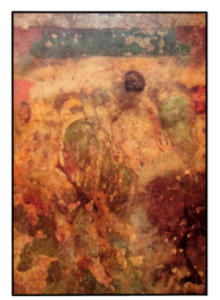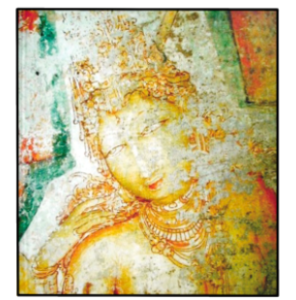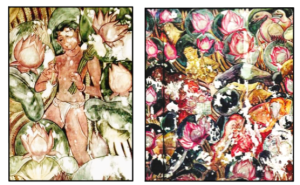Even after Ajanta, very few sites with paintings have survived, which provide valuable evidence to reconstruct the tradition of paintings. The sculptures, too, were plastered and painted. In many places where carving and painting were carried out simultaneously, the tradition of cave excavation continued.
Badami murals:
- These are seen in Badami, Karnataka, the capital of the early Chalukyan dynasty.
- Patrons: Chalukyan king Mangalesh (younger son of Pulakesi I and brother of Kirtivarman I).
- Painting Themes:
- Vishnu images are present in Cave No.4, and this cave is popularly known as the Vishnu cave. It may be presumed that the patron records his Vaishnava affiliation.
- Palace scenes: Kirtivarman, the son of Pulakesi 1 and the elder brother of Mangalesha, seated inside the palace with his wife and feudatories watching a dance.
- Figures of Indra and his retinue are found towards the corner of the panel.

Fig: Queen and attendants, Badami
Source: Figure Queen and attendants, Badami, Chapter 5 – Class 11 Art and Culture, Later Mural Tradition, NCERT
Features:
- Stylistically, these extend the tradition of mural paintings from Ajanta to Badami in South India.
- Like Ajanta, the faces of the king and the queen are gracefully drawn. Their lips are protruding; eye sockets are large and half-closed.
- The sinuously drawn lines, fluid forms, and compact composition exemplify the proficiency and the maturity the artists had achieved in the sixth century CE.
Mural Tradition under the Kingdoms of Pallava, Pandya, and Chola
Pallava murals:
- Like their predecessor Chalukyas, the Pallavas were also patrons of the arts.
- Mahendravarman 1 was responsible for building temples at:
- Mandagapattu Temple: The inscription mentions Mahendravarman 1 with numerous titles such as Vichitrachitta (curious-minded), Chitrakarapuli (tiger among artists), Chaityakari (temple builder).
- Panamalai Temple: A figure of a female divinity is drawn gracefully.
- Kanchipuram Temple: Paintings were patronized by the Pallava king Rajsimha.
- Features: Faces are round and large. The Lines are rhythmic with increased ornamentation compared to the paintings of an earlier period. The Depiction of the torso remains like the earlier sculptural tradition but is elongated.

Fig: Devi – seventh century CE, Panamalai
Source: Figure Devi – Seventh Century CE, Panamalai, Chapter 5 – Class 11 Art and Culture, Later Mural Tradition, NCERT
Pandya tradition:
- The Pandyas too patronized the art. Some noteworthy examples include Tirumalaipuram caves and Jain caves at Sittanavasal.
- Features:
- The paintings can be seen on the ceilings of shrines, in the verandas, and in the brackets.
- One can see the Dancing figures of celestial nymphs on the verandah pillars.
- The contours are firmly drawn and painted vermillion red on a light background.
- The body is rendered in yellow. Their eyes are slightly elongated.

Fig: Sittanvasal – early Pandya period, ninth century CE
Source: Figure Sittanvasal – early Pandya Period, Ninth Century CE, Chapter 5 – Class 11 Art and Culture, Later Mural Tradition, NCERT
Chola Tradition:
- The Cholas reached their zenith of power in the eleventh century, and then their masterpieces of art and architecture began to appear.
- The temples Brihadeshwara at Thanjavur, Gangaikonda Cholapuram, and Darasuram in Tamil Nadu were built during the reigns of Rajaraja Chola, his son, Rajendra Chola, and Rajaraja Chola 2, respectively.
- These paintings were drawn on the walls of the narrow passage surrounding the shrine.
- When they were discovered, two layers of paintings were found. The upper layer of the painting was done in the sixteenth century during the Nayak period.
- Themes: The narratives and aspects related to Lord Shiva, Lord Shiva in Kailash, Lord Shiva as Tripurantaka, Lord Shiva as Nataraja, the portrait of a patron god Rajaraja and his mentor Kuruvar, dancing figures.
Conclusion
The sculptures were plastered and painted and the tradition of cave excavations continued further at many places where sculpting and painting were also developed hand in hand. Even today, mural paintings can be observed on interior and exterior walls of houses in villages or havelis is prevalent in different parts of the country. Generally, these paintings are made by women either at the time of ceremonies or festivals or as a routine to clean and decorate the walls.
 Profile
Profile Settings
Settings Refer your friends
Refer your friends Sign out
Sign out













